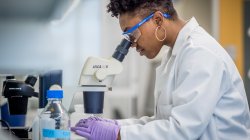Zero Compromise Towards Safety
Safety and Industrial Hygiene encompasses many disciplines. Collectively they seek to make the workplace a safe one for employees and contractors. Most safety professionals have at least a general understanding of these many disciplines, but the complexity of some require the perspective of a specially trained professional. If one is not available on-site, Montclair State University has specialists located close enough to be available if the need arises.
Take the time to become familiar with these critical safety and industrial hygiene areas. Many of them are part of your everyday work.
The actions recommended in the following section are applicable to Montclair State University. If applicable Local and State regulations are more stringent than the recommendation, EHS shall comply accordingly.
What Is Industrial Hygiene (IH)?
Industrial hygiene is the science of identifying, evaluating and controlling workplace hazards such as chemicals, dusts, fumes, noise, vibration and extreme temperatures.
Why Is IH Important?
The educational and maintenance activities we conduct on campus can require the handling of chemical substances, use of dangerous power tools, and heavy lifting. IH requires that these workplace hazards are correctly assessed and exposure controls are used to reduce any potential harmful effects.
There are two critical components of IH:
- Hazard communication ensures employees are aware of the hazards employed with the hazardous substances and work they are exposed to.
- Workplace risk assessments help us understand the exposure levels faced by employees when performing their job. These risk assessments help us develop and implement proper work practices and procedures.
The introduction of new agents (chemical, physical and biological), or a change that involves agents that are already in use, must be evaluated by EHS. Proper controls can be integrated into the design stage to avoid bottlenecks and help ensure the smooth progress of projects.
What Should I Do?
- Properly train employees to handle the chemical, physical and biological agents in their work areas, and ensure they follow the established safe work practices and procedures.
- Provide employees with the appropriate personal protective equipment (PPE) and respirators required in training, and enforce PPE use.
- Make sure that the necessary risk assessments for all chemical, biological and physical agents in the workplace are conducted, documented and communicated.
- Take action when employees don’t use PPE or don’t comply with maintenance requirements.
- Inform EHS of all changes in the handling of agents (new activity, new agent, or a change in process) as soon as the changes are being discussed.
- Make sure hearing and respirator medical surveillance is conducted annually.
